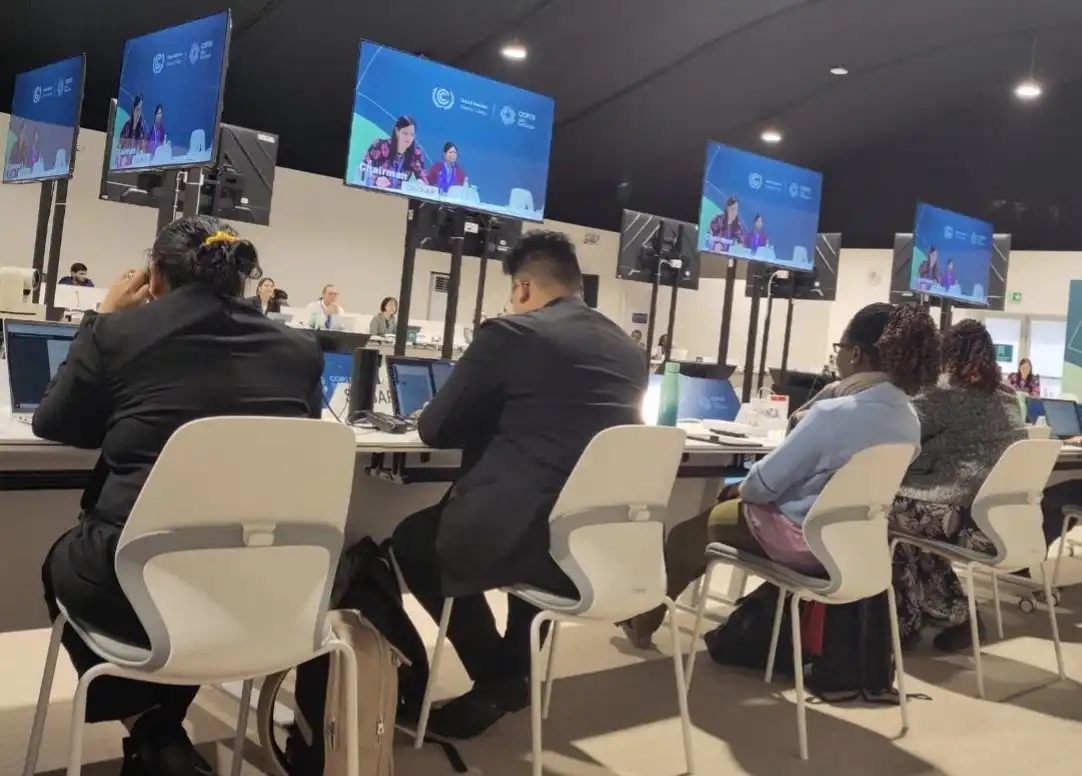Home>COP29 in Baku: Chronicles From the Field by Our Center for International Studies
20.11.2024
COP29 in Baku: Chronicles From the Field by Our Center for International Studies

It’s COP time again. For the 29th time, Parties to the UN Framework Convention on Climate Change (or UNFCCC) are meeting to discuss how to reach the Convention’s ultimate objective of preventing “dangerous” interference with the climate system. While not quite as the record-breaking COP28 in Dubai last year, which attracted around 100,000 attendees from around the world, COP29 is still a mega-event, with an estimated 30 to 40,000 participants.
Read the “Day 9 report” by Carola Klöck, researcher at Sciences Po Center for International Studies (CERI), who is attending this COP29 along with PhD students Sarah Tegas and Sarah Thompson.
> Discover the rest of the COP29 field reports on the CERI/lab website.
DAY 9, 19 November 2025: Ministers have arrived
From Carola Klöck.
We’re in the second week of the COP. Ministers have arrived and discussions on the thorniest issues that could not be resolved at the so-called “technical” level last week have now moved to the “political” level. These high-level negotiations tend to take place behind closed doors, leaving observers like us in the dark or dependent on rumours in the corridors.
Walking back and forth at the COP29
These different levels of negotiations show again just how complex and multi-layered these COPs are. We have already talked about the different spaces at the venue: the Green Zone, the Blue Zone, the pavilions, side events, and actual negotiation rooms, plus delegation offices, bilateral meeting rooms, or space for the media. Actually, we spend considerable amounts of time walking from one end of the venue to another, and back. Small states – at the centre of our research project – may not even be able to visit and cover these different spaces. I have heard from negotiators that they have not yet been to the pavilion area at all, let alone the Green Zone (which is across the street and requires going through security controls). Others, in contrast, may only have visited the pavilion area. Many delegations indeed have separate teams for separate objectives: a team to look after the pavilions or to speak at side events, and a team for the actual negotiations. Larger delegations here clearly are at an advantage, while smaller delegations have to choose where to go and what to attend.
On the size of delegations
Carbon Brief has analysed the provisional list of participants to find out which countries actually sent the largest delegations. Despite expectations that this COP would be much smaller than the record-breaking Dubai COP from last year, it seems that Baku actually ends up being the second-largest COP ever, just behind the Dubai COP. Unsurprisingly, the host country’s delegation is by far the largest one, with over 2,000 people in total. This is in stark contrast to previous COPs, where Azerbaijan had actually very small delegations of only 5 to 11 people (for the COPs between 2016 and 2022). France shows the opposite trend: the French delegation is much smaller this year than in previous COPs, given political tensions with the host countries.
Political tensions also explain why Armenia has not sent even one delegate. Argentina has had a small delegation but ordered all delegates back last week Wednesday, while Papua New Guinea has already announced in August that it would “boycott” the negotiations given the disappointing results. In fact, Papua New Guinea has a (relatively small) delegation but decided not to send a minister.
When presence equals to engagement equals to influence
Our project wants to examine such dynamics more closely, and explore presence in more detail. We argue that presence is a precondition for engagement, which in turn is a precondition for influence. We therefore want to understand who is present – as well as who is absent – but also who the delegates on the ground, e.g. whether countries send ministers or not. Such information is key to understanding negotiation dynamics, and although presence is such a fundamental aspect of negotiations, it has been surprisingly little studied in international relations and negotiation research.